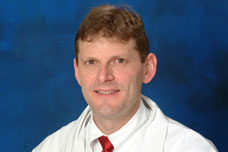 |
Moving fast on strokes
Rapid response program improves care for Orange County stroke victims
This results in delaying measures that can save lives and greatly reduce long-term disability.
"Studies show that immediate treatment in the early stages of a stroke can significantly improve outcomes for patients," says Dr. Steven C. Cramer, a UC Irvine neurologist and stroke researcher.
"The key is to have a system in place to quickly recognize stroke symptoms, properly triage patients and then deliver them to a hospital that is prepared to rapidly assess their condition and begin treatment."
The nationally certified Comprehensive Stroke and Cerebrovascular Center at UC Irvine Medical Center offers such patients state-of-the-art diagnosis and treatment-including specialty care by interventional radiologists. But creating a system to spread that expertise regionally had long been a goal of Cramer's.
In April 2009, Orange County's Health Care Agency designated UC Irvine Medical Center a Stroke-Neurology Receiving Center. It joined five other such sites offering high-level neurovascular care to which paramedics and ambulance drivers take stroke cases.
"This was an enormous step forward for the health of Orange County's residents," Cramer says.
The Stroke and Cerebrovascular Center has held advanced certification from The Joint Commission since 2004 and was among the nation's first academic medical facilities to be designated a primary stroke center. It won recertification and the commission's Gold Seal of Approval in March 2010.
Not all hospitals have the resources or personnel to effectively treat a stroke. The county requires that a Stroke-Neurology Receiving Center have a dedicated medical director, an emergency-medicine physician on-site at all times, and a neurologist, neurosurgeon and radiologist always on call.
UC Irvine Medical Center also has an interventional neuroradiologist available around the clock capable of extracting a stroke-inducing blood clot by inserting a catheter into the arteries supplying a patient's brain.
Another advance in stroke treatment is the clot-busting drug tPA-tissue plasminogen activator. However, it must be administered within three hours of the onset of symptoms to avoid permanent brain damage. Yet only about 3 percent of U.S. stroke patients reach a hospital quickly enough to be considered for this treatment. The Stroke-Neurology Receiving Center system promises to improve those chances.
Orange County was the first in Southern California to establish such a system, joining several other California counties, such as Santa Clara and San Francisco, and states such as New York.
Previously, emergency services could only diagnose a stroke and tell the patient's family "to hope for the best" as they rushed to the nearest hospital, says Dr. Samuel J. Stratton, medical director of Orange County's Emergency Medical Services system, which honored Cramer for spearheading the program's creation.
"Now in Orange County medics recognize the signs of stroke and take the patient to a Stroke-Neurology Receiving Center, where an entire team will provide care, like a trauma team," Stratton said.
"We owe Dr. Cramer an incredible amount of gratitude."
— John Murray, UC Irvine Health Affairs Communications
In April 2009, Orange County's Health Care Agency designated UC Irvine Medical Center a Stroke-Neurology Receiving Center. It joined five other such sites offering high-level neurovascular care to which paramedics and ambulance drivers take stroke cases.
"This was an enormous step forward for the health of Orange County's residents," Cramer says.
The Stroke and Cerebrovascular Center has held advanced certification from The Joint Commission since 2004 and was among the nation's first academic medical facilities to be designated a primary stroke center. It won recertification and the commission's Gold Seal of Approval in March 2010.
Not all hospitals have the resources or personnel to effectively treat a stroke. The county requires that a Stroke-Neurology Receiving Center have a dedicated medical director, an emergency-medicine physician on-site at all times, and a neurologist, neurosurgeon and radiologist always on call.
UC Irvine Medical Center also has an interventional neuroradiologist available around the clock capable of extracting a stroke-inducing blood clot by inserting a catheter into the arteries supplying a patient's brain.
Another advance in stroke treatment is the clot-busting drug tPA-tissue plasminogen activator. However, it must be administered within three hours of the onset of symptoms to avoid permanent brain damage. Yet only about 3 percent of U.S. stroke patients reach a hospital quickly enough to be considered for this treatment. The Stroke-Neurology Receiving Center system promises to improve those chances.
Orange County was the first in Southern California to establish such a system, joining several other California counties, such as Santa Clara and San Francisco, and states such as New York.
Previously, emergency services could only diagnose a stroke and tell the patient's family "to hope for the best" as they rushed to the nearest hospital, says Dr. Samuel J. Stratton, medical director of Orange County's Emergency Medical Services system, which honored Cramer for spearheading the program's creation.
"Now in Orange County medics recognize the signs of stroke and take the patient to a Stroke-Neurology Receiving Center, where an entire team will provide care, like a trauma team," Stratton said.
"We owe Dr. Cramer an incredible amount of gratitude."
— John Murray, UC Irvine Health Affairs Communications
